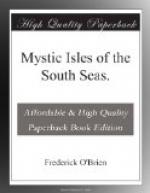The village of Vaieri is opposite the pass of Tapuaeraha. Far from the capital, and from the distractions of tourists and bureaucracy, this tiny group of homes along the beach was less touched by the altering hand of the white than Mataica, its setting and atmosphere affectingly unspoiled. There was a mildness, a reticence, a privacy surrounding the commune that bespoke a gentle people, living to themselves. It was almost at the end of the belt road, which virtually terminated at Puforatiai. Gigantic precipices, high cliffs, and rugged mountains forbade travel, and from a boat only could one see the extreme southern end of Tahiti-nui Marearea, Great Tahiti the Golden, as it was called by its once proud race.
Vaieri was environed by all the plants of this clime. They ran along the road and embosomed the houses. Guavas and oranges were tangled with bananas, roses, reeds, papayas, and wild coffee. The blue duranta and the white oleander, the cool gray-green hibiscus with lemon-colored blossoms, the yellow allamanda, the trumpet lily, acacias, lilac ipomaea, tree ferns, and huge bird’s-nest ferns mingled with white convolvulus, and over all lifted groves of cocoas and the symmetrical breadfruit.
In this surrounding was a wooden house, built partly over the water, so that a seaward veranda extended into the lagoon, high on posts, and commanded a view of the sea and the mountain. I saw on this veranda a more arresting figure of a white man than I had before come upon in Tahiti. His body, clothed only in a pareu, was very brown, but his light beard and blue eyes proved his Nordic strain. He was of medium size, powerful, with muscles rounded, but evident, under his satin skin, and with large hands and feet. He was reading a book, and as I ambled by, he raised his head and looked at me with a serious smile.
I checked the horse, and tied him to a candlenut-tree. I felt that I had arrived at the end of my journey.
I spent the remainder of the day and the night there. The man and his wife were as stars on a black night, as music to a blind bard. His name was Nicolai Lermontoff, born in Moscow, and his wife was an American, Alaska her place of birth, and of residence most of her life. They were each about forty years old, and of extraordinary ease of manner and felicity of expression.
“Muy simpatica,” had said the old Gipsy at the Generalife in Granada when I had spoken bolee with him. Lermontoff shook hands with me. His was as hard as leather, calloused as a sailor’s or a miner’s, and so contradicted his balanced head, intellectual face, and general air of knowledge and world experience that I said:
“You have the horniest palm in Tahiti.”
“I am a planter,” he replied. “We have been here a few years, and after buying the ground I had to clear it, because it had been permitted to go to bush. There were a few hundred cocoanut-trees, but nothing else worth while. I began at the highest point and worked to the sea.”




